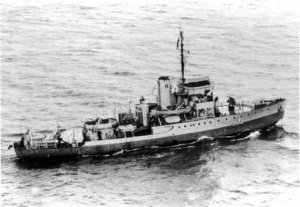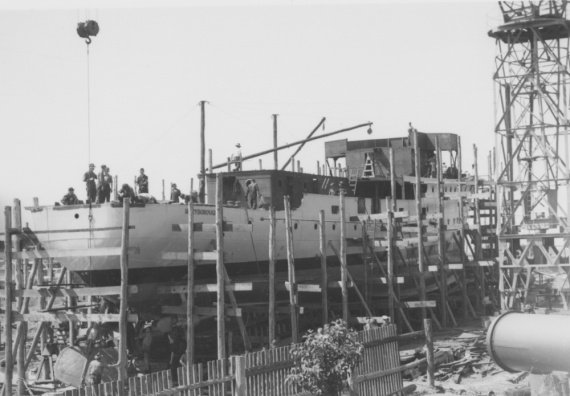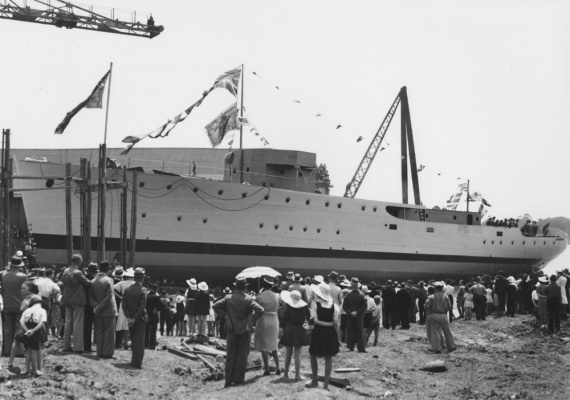HMAS Maryborough (I)
| Class |
Bathurst Class |
|---|---|
| Type |
Australian Minesweeper |
| Pennant |
J195 |
| Builder |
Walkers Ltd, Maryborough |
| Laid Down |
16 April 1940 |
| Launched |
17 October 1940 |
| Launched by |
Mrs Goldsmith, wife of the General Manager, Walkers Ltd |
| Commissioned |
12 June 1941 |
| Decommissioned |
December 1945 |
| Fate |
Paid off December 1945 |
| Dimensions & Displacement | |
| Displacement | 650 tons |
| Length | 185 feet 8 inches |
| Beam | 31 feet |
| Draught | 8 feet 6 inches |
| Performance | |
| Speed | 15 knots |
| Complement | |
| Crew | 85 |
| Propulsion | |
| Machinery | Triple expansion, 2 shafts |
| Horsepower | 1750 |
| Armament | |
| Guns | 1 x 4-inch gun |
| Other Armament | 3 x Oerlikons |
| Awards | |
| Battle Honours | |
HMAS Maryborough was one of sixty Australian Minesweepers (commonly known as corvettes) built during World War II in Australian shipyards as part of the Commonwealth Government’s wartime shipbuilding programme. Twenty (including Maryborough) were built on Admiralty order but manned and commissioned by the Royal Australian Navy. Thirty six were built for the Royal Australian Navy and four for the Royal Indian Navy.
Maryborough commissioned at Maryborough on 12 June 1941 under the command of Lieutenant Commander Glen L Cant, RAN.
Maryborough, after a brief period of service on the east coast of Australia, proceeded in November 1941 to Singapore. There on 28 November she became a unit of the 21st Minesweeping Flotilla. Following the outbreak of the Pacific War, Maryborough with six of her sister ships played a notable part in the Malayan-Java-Sumatran operations ending on 2 March 1942, when she departed Tjilatjap for Fremantle.
The period of March to November 1942 was spent on escort and patrol duties in Western Australian waters based on Fremantle. It was an uneventful period. During April 1942 Maryborough took the submarine USS Sea Raven in tow and brought her to Fremantle. The submarine, which had rescued a party of servicemen from Timor, had broken down. On 3 November 1942 Maryborough departed Fremantle for Diego Garcia en route to join the Eastern Fleet. The following four months were spent escorting shipping from Colombo to Bombay and to the Persian Gulf.
In May 1943 Maryborough entered the Mediterranean. Five months were spent in this theatre on convoy, escort and anti-submarine patrol, including the operations for the Sicily landings.
In November 1943 Maryborough returned to the Indian Ocean and resumed her convoy escort duties. After a year of these activities she returned to Fremantle on 3 December 1944 after more than two years of overseas service.
Three and a half months in Australian waters had elapsed when on 16 March 1945 she departed Sydney for Seeadler Harbour. Maryborough spent the remaining months of the war on patrol in Australian and New Guinea. On 15 August 1945 (‘VJ’ Day) Maryborough was en route from Milne Bay to Seeadler.
The remainder of her active service with the RAN was spent as a unit of the 21st Minesweeping Flotilla based on Hong Kong. In December 1945 she finally returned to Australian and was paid off for disposal. She was sold to Australian General Trading and Shipping Syndicate, Sydney (Comino Bros Pty Ltd) on 9 May 1947 and renamed Isobel Queen. She was resold to Carr Enterprises Ltd, Sydney, in 1953 for breaking up.
Note: This video is hosted on YouTube. Department of Defence users will not be able to view this video on the Defence Protected Network.
This cine film has been placed online as part of the Sea Power Centre - Australia’s ongoing archival digitisation program.
Further Reading
- The history of HMAS Maryborough: Corvettes in World War II, 1940-1946, by Brian Ogle - published by F Ogle, 1992.
- The Corvettes: Forgotten Ships of the Royal Australian Navy, by Iris Nesdale - published by the author, October, 1982.
- Corvettes - Little Ships for Big Men, by Frank B Walker - published by Kingfisher Press, NSW, 1996.
- The Australian Centenary History of Defence Volume III, The Royal Australian Navy, edited by David Stevens, Oxford University Press, South Melbourne, Victoria, Australia, 2001.













